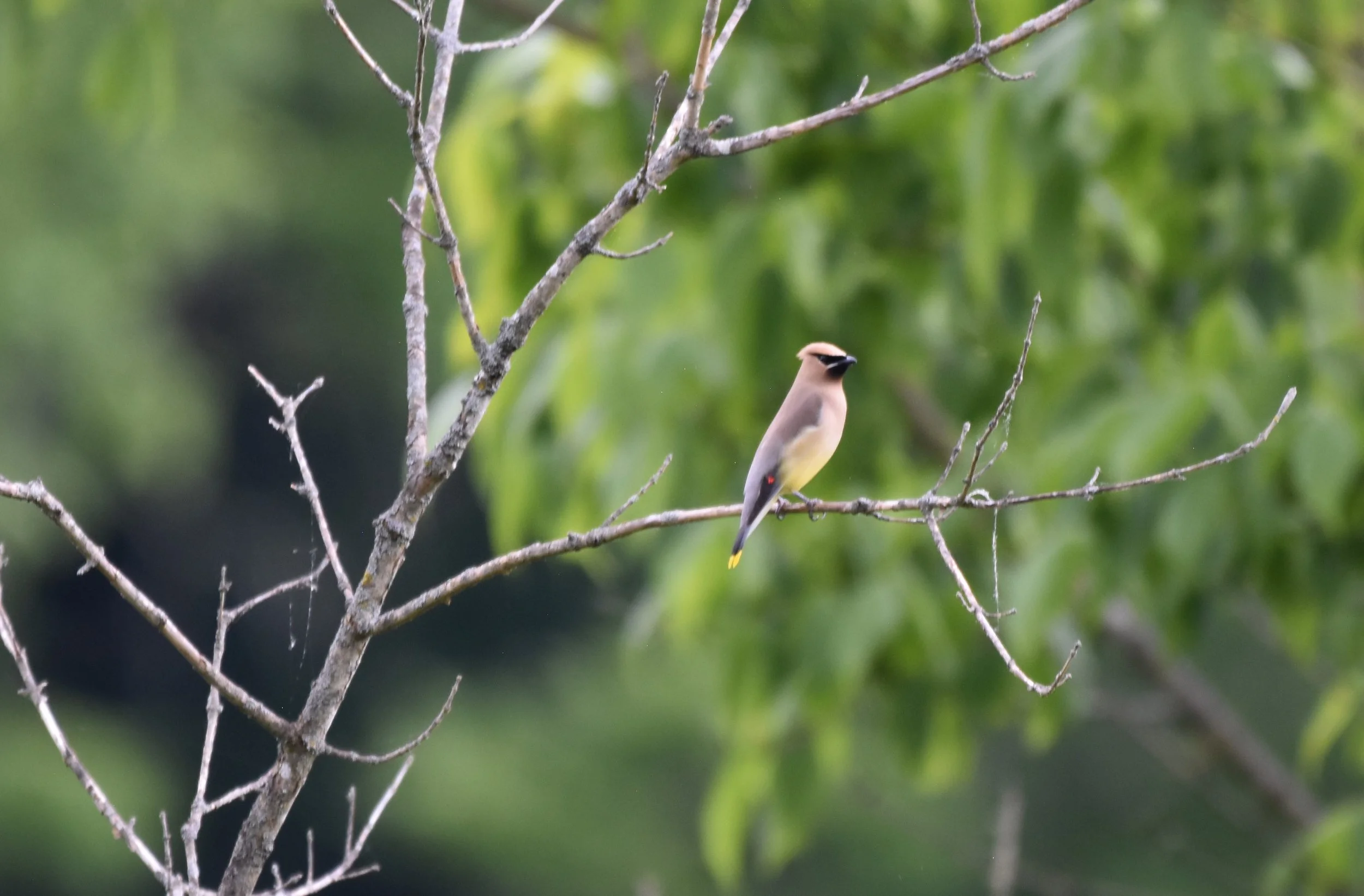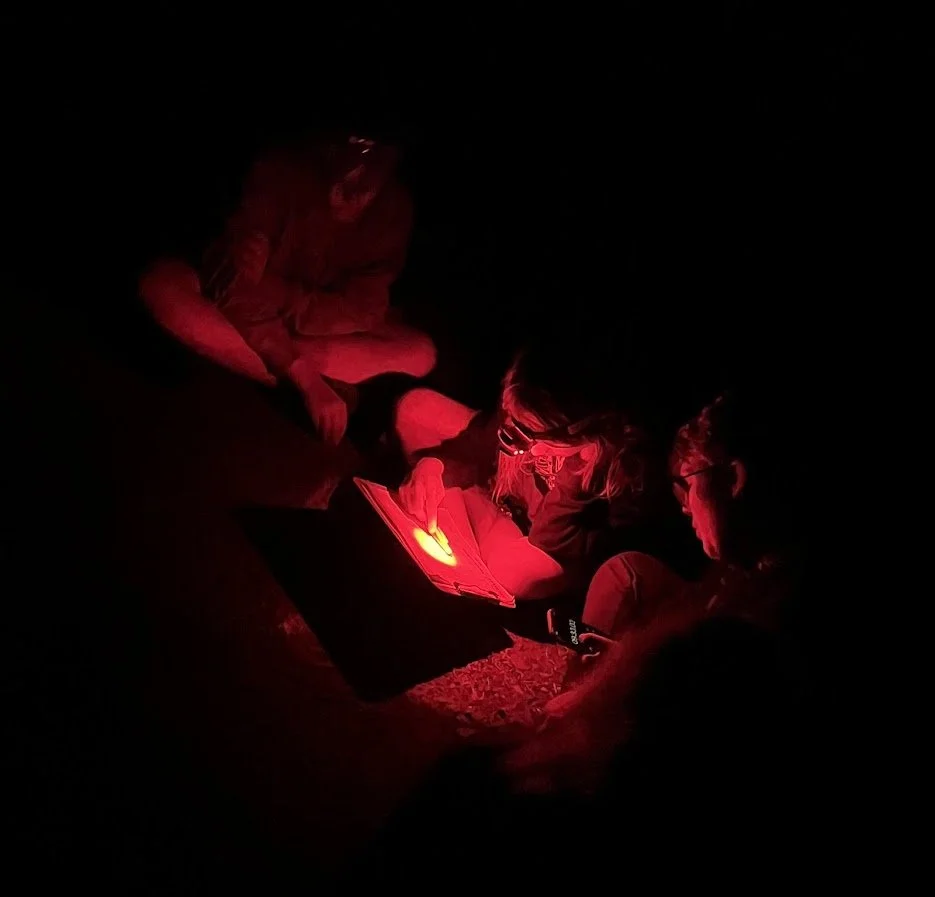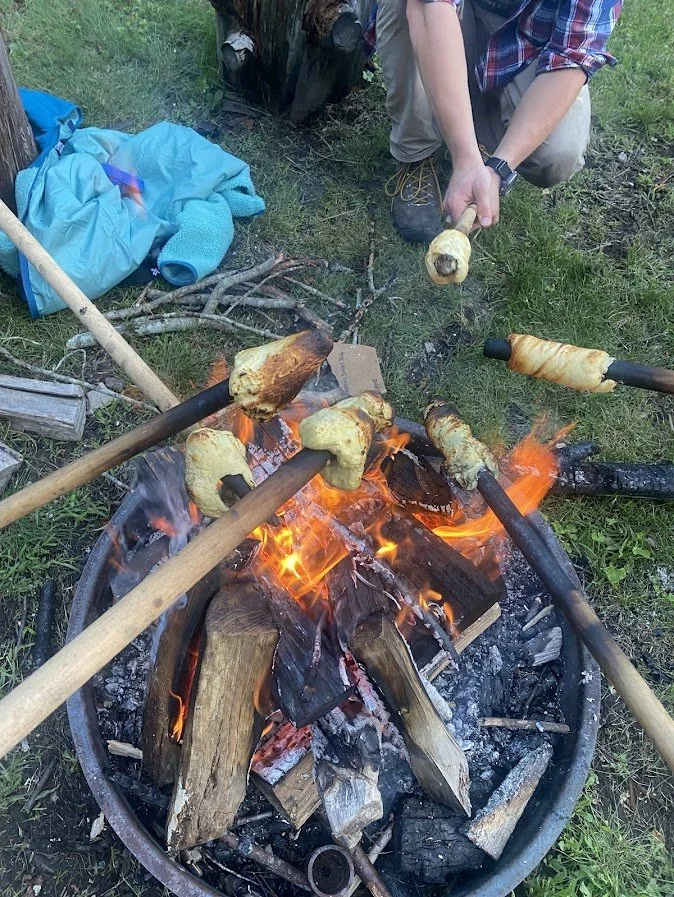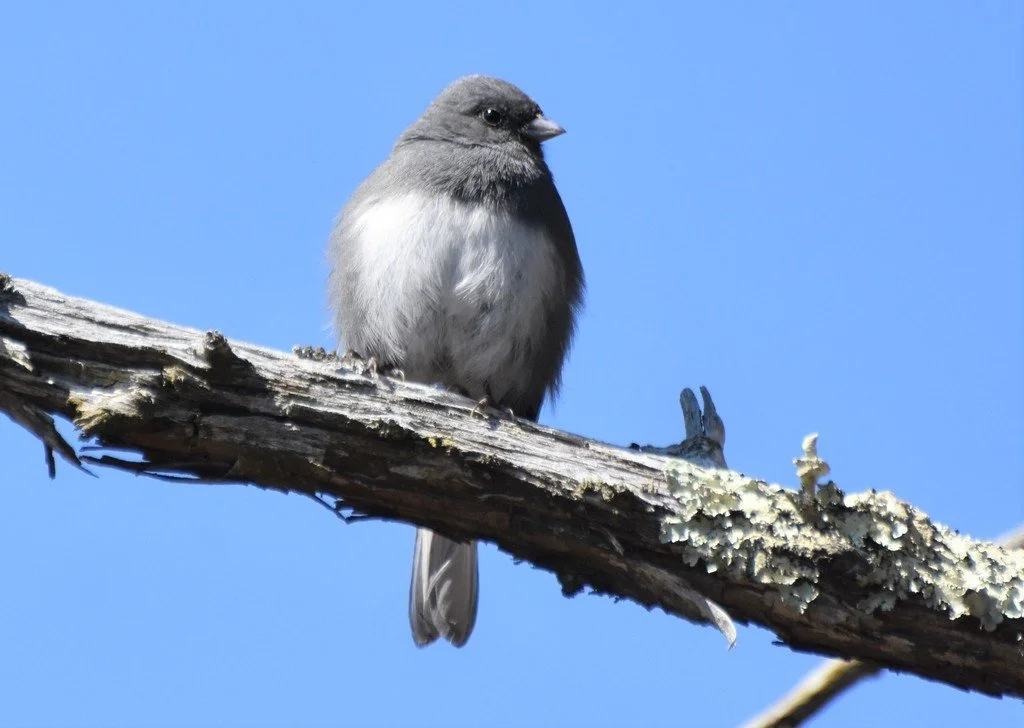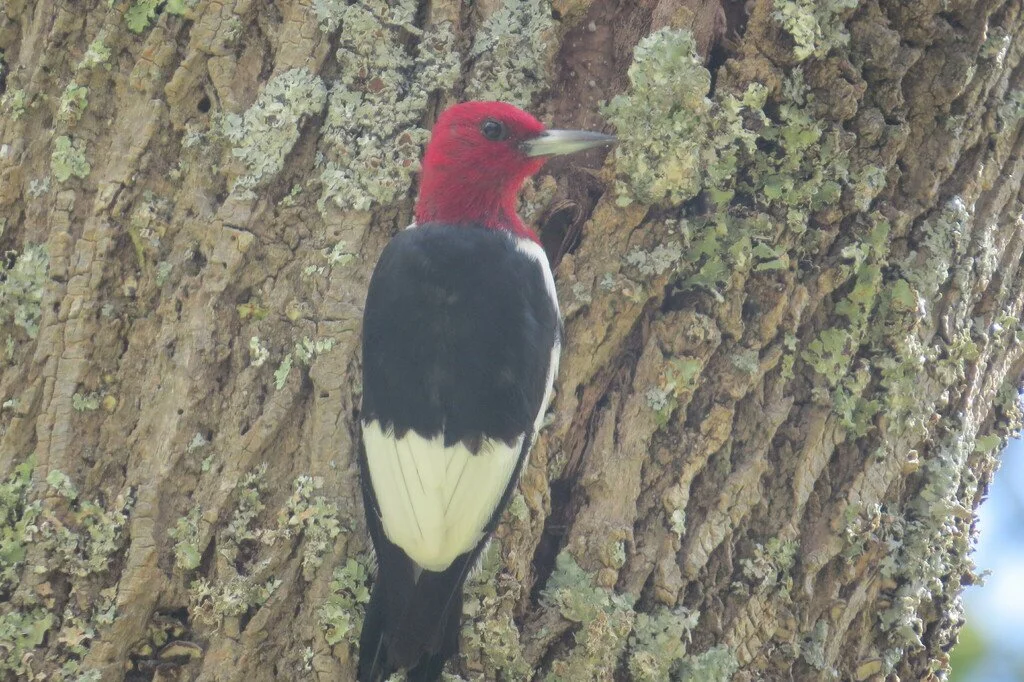Ornithology Camp 2024
Cedar Waxwing
Ornithology Camp 2024 was a success, with a lot of fun times following high mountains, green valleys, and gurgling rivers in search of unusual birds in the “Wild West of Virginia.” From early mornings hiking the balds for warbler surveys and an incredible sunrise before daybreak, to late nights in the firefly-swarmed woods surrounded by a family of owls, we had some great young birders who enjoyed it all, with excitement and curiosity with every species, baked cinnamon apples from the coals of a campfire, and plenty of laughter. We ended the trip with 97 species, and many fascinating secrets about the avian world were unveiled.
Researching tree swallow nesting habits.
Day one was spent learning tips and tricks to use optics (binoculars, spotting scope), how to use a field guide to identify birds, and how to find and journal about birds in the wetland. We had lots of good views of twelve species of common highland birds, including Red-winged Blackbird, Indigo Bunting, Cedar Waxwing, American Goldfinch, and Pileated Woodpecker. For the first day and a half, local ornithologist Bobby Riggs shared his birding expertise in the area and across the U.S., talking about raptors and each of the biomes we would be visiting with a presentation from the Virginia Ornithological Society featuring his study. After dinner, we played some bird-related games, and announced the challenge for each young birder to research a species and think of a creative way to share their information with peers. We ended the day with s’mores around a campfire, followed by a high-elevation search for Northern Saw-whet Owls on Whitetop Mountain at night.
Northern Saw Whet Owl survey in the spruce forest of Whitetop Mountain.
Day two was an early start, and we loaded up the van on the way to Fairwood Valley just after daybreak. We stopped at Grindstone Campground to search for neotropical migrants; the tiny colorful birds that make a cross-continental journey to the cove forests of Mt. Rogers. In the dark thickets of rhododendron, Sam spotted a singing male Magnolia Warbler (considered a rarity at this time of year in the state), and after that the forest exploded into warbler songs and territorial battles. Black-throated Blue Warbler, Canada Warbler, Chestnut-sided Warbler, Black-throated Green Warbler and American Redstart among many others were showing off in the dense, chilly forest. The alien songs of the cinnamon-colored thrush called a Veery filled the forest. One even chased the green light of our laser pointer, just like a pet house cat! Once we found as many species as time would allow, we traveled to Homestead Road to look for some other mountain-dwelling species. At the top of the ridge, a fire-colored Blackburnian Warbler sang in the canopy of white pine trees, an Eastern Wood-Pewee was sallying for stoneflies over the road, and we got excellent looks at a male Hooded Warbler angrily chipping at us, before turning back down the long, gravel road towards Konnarock.
Hooded Warbler
After stopping back at the Center for lunch, we crossed Iron Mountain in the van and ventured off to Saltville. In Chilhowie, we picked up a hitchhiker with his thumb extended on the side of the road (in typical hitchhiker fashion); it was Bobby Riggs. There, we followed the ancient route of mastodons and woolly mammoths on the Helen Barbrow trail, where Osage Orange trees were loaded with poisonous, glue-filled fruit, swamp hibiscus, and saltmarsh bulrushes grow in the only inland, saltwater habitats in the Appalachian Mountains. Here, we found Green Herons hunting in the swampy fringes of degraded wetlands, a Great Blue Heron hunting bluegill, a pair of Belted Kingfishers, a female Orchard Oriole, a vibrant male Scarlet Tanager singing from a snag, White-eyed Vireo, Yellow Warbler, and Killdeer in addition to other low-elevation birds. As we crossed a clearing beside the wellfields, Noah spotted a “lost” seabird flying low over the water, a Black Tern!
Black Tern
As everyone watched the out-of-place bird fighting against a light rain, it dove repeatedly to catch mosquitofish in the rippling, muddy waters in a needle-like bill. Black Terns are small, elegant seabirds that normally spend the breeding season inland across the Canadian boreal forest and plains, where they build floating nests of reeds in clear, remote lakes. This tern evidently decided to travel south early to spend at least a day hunting over the brackish water of Saltville, giving everyone a chance to see a very rare bird for Southwest Virginia. After watching the tern dance over the water, we were rushed back to the van by a powerful downpour. The young birders were intrepid explorers and didn’t let it bother them. Back at the Center, we hiked to the Benish property and had amazing views of a pair of Ovenbirds, a drumming Hairy Woodpecker, and a screeching Broad-winged Hawk that circled low overhead. We finished the day with a campfire, singing and playing some old Appalachian bluegrass and old-time songs, and a successful owling trip behind the Center, calling in a family of Eastern Screech Owls that spent a few minutes swooping from tree to tree overhead.
“Biscuits-on-a-stick” around the campfire
Day three started bright and early, at 5:30 AM! We ate breakfast on the road and rode the van to Elk Garden for a Golden-winged Warbler survey. Each young birder had the opportunity to take the data about the habitat and notable species as we hiked between boulders, blueberry bushes, and brambles. Black-capped Chickadee (not the usual, common Carolina Chickadee in the area), the endemic Carolina Dark-eyed Junco, a tiny and inconspicuous Least Flycatcher, great views of a Common Yellowthroat, and several other new birds were found on the mountain. After the survey was complete, we ventured up to Whitetop Mountain and located birds that only breed in the spruce-fir forest and other high-elevation conifer forests and balds in Virginia, found nowhere else in the state (at least in the summer). Among these birds were very friendly Red-breasted Nuthatches, Golden-crowned Kinglets chattering to each other in the spires of red spruce trees, a Yellow-rumped Warbler in breeding plumage, a singing Hermit Thrush, and a flyover Common Raven! We also had amazing views of the Blue Ridge Mountains spanning toward Tennessee and North Carolina in the morning light, before returning for lunch. Before leaving, we saw a large flock of tiny Pine Siskins, and a small flock of large, Appalachian (Type 1) Red Crossbills. Both are nomadic finches that depend on cold, coniferous forests to survive. Few exist in the South, but the spruce forest on Whitetop Mountain provides a refuge for both species to thrive, even in a year with a bad cone crop.
Dark-eyed Junco, “Carolina” subspecies
After lunch, another local ornithologist Dr. Steven Hopp joined us for a presentation about bird behavior and nesting ecology, and his long-term research with vireos. There were many great stories about birds from the Appalachians of Virginia and around the world, accompanied by the many photos, sounds, and data Dr. Hopp has collected locally and abroad. After the presentation, we made field trip to the South Fork of the Holston River.
Dr. Hopp teaching important aspects of bird behavior, by pointing out a pair of Downy Woodpeckers feeding on a nest of turfgrass ants.
We walked through a walnut orchard and hayfields on the Bishop farm in the valley. Our first bird was a male American Kestrel, North America’s smallest falcon hovering over the grasses with blue-and-orange wings. The attention was quickly stolen by a beautiful Red-headed Woodpecker (not to be confused with the other, more common species incorrectly called “red-headed woodpeckers”). Purple Martins hunted over the field, tiny Blue-gray Gnatcatchers hissed at us from a wild cherry tree hanging over the river, and Dr. Hopp pointed out the leaf-like, almost-invisible Warbling Vireo singing high in a sycamore tree. Once we returned, each of the students shared their own presentations, drawing inspiration from the visiting ornithologists. The day ended with a final campfire with baked apples, and a search for Barred Owls in Fairwood Valley.
Red-headed Woodpecker
Day four was the final morning trip. With eighty-five species, we tried to get to a hundred. Most of the bird species found in Southwest Virginia were checked off on our large, double-poster master species list for the camp. Our final destination was the Buller Fish Hatchery land, with wetland habitats and warmer cove forests. We had some amazing finds here, including a male Baltimore Oriole mobbing a Bald Eagle, a freshly hatched Wood Duck ducklings and their mothers, a signing Wood Thrush, an Acadian Flycatcher in the hemlock trees across the river, and great looks at a singing Black-and-White Warbler foraging vertically on the tree trunk. Our last species was found in the pastures of St. Clair’s Bottom on the way back to the Blue Ridge Discovery Center, an Eastern Meadowlark soaring across the field to land on a barbwire fence, a farewell of encouragement to all the young birders.
“The sweep,” in birder slang. A rushed, last-minute effort to find as many new species as possible, which happened at Buller Fish Hatchery for Ornithology Camp 2024.
We want to extend a big thanks and acknowledgement to the Blue Ridge Birders and Naturalist Rally attendees for supporting the William Roberts Ornithology Camp scholarship, to make this camp possible for local kids interested in birds and wildlife in the Blue Ridge Mountains.
